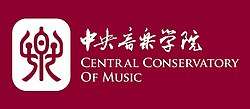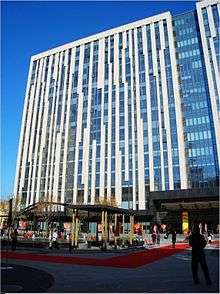Central Conservatory of Music
The Central Conservatory of Music (Chinese: 中央音乐学院; pinyin: Zhōngyāng Yīnyuè Xuéyuàn) is a prestigious leading music school of China. Its campus is in the Xicheng District of Beijing, China, near Fuxingmen Station. It is a Chinese Ministry of Education Double First Class Discipline University, with double First Class status in certain disciplines.[1]
中央音乐学院 | |
 | |
| Motto | 勤奋,求实,团结,进取 (Mandarin) |
|---|---|
Motto in English | Diligent, looking for truth, organization, advance |
| Type | Public |
| Established | 1950 |
| President | 俞峰 Yu Feng |
Academic staff | 340 |
| Students | 1897 |
| Undergraduates | 1469 |
| Postgraduates | 360 |
| 69 | |
| Location | , |
| Website | www.ccom.edu.cn |

Overview
Founded in 1950, the conservatory offers courses to both Chinese nationals and foreign students, and caters for all levels from primary up to postgraduate programmes. Undergraduate programmes of four or five years are offered in composition, conducting, musicology, voice and opera, piano, orchestral instruments, and traditional Chinese musical instruments; there is a six-year middle school with courses in piano, orchestral instruments, traditional instruments and music theory; and two primary schools cater for full-time and evening students. There is also an evening university for mature students.
In recent years, the conservatory has developed strong relationships with overseas institutions and individuals. Foreign musicians and scholars are frequently invited to teach or offer lectures at the conservatory which, in turn, also sends its own faculty members and students to other countries to pursue further studies, lecture, or give performances. Conservatory students and teachers participate in the China Youth Symphony Orchestra, the Chinese Traditional Musical Instruments Ensemble, the Conservatory Students Chorus, the Middle School Students Orchestra and the Primary School Students Performing Group, all of which have performed to much acclaim on every continent.
The conservatory campus covers 53,000 square metres in the centre of Beijing comprising a complex of traditional and modern buildings. The Conservatory Music Library accommodates over 500,000 volumes and is the largest of its kind in China. The conservatory also owns over 500 pianos and a large number of other musical instruments; its educational facilities include an electronic music studio with advanced recording and video equipment, and a violin workshop. New: 1 Oberlinger-organ from Germany Nov. 2013
The conservatory publishes the Journal of the Central Conservatory of Music. It is generally considered to be the top academic journal in the field of musicology in China.
Degrees offered
- Bachelor's degrees (4 years)
- Musicology (5 years)
- Composition and Compositional Theory (5 years)
- Vocal Singing (5 years)
- Conducting (5 years)
- Keyboard Instruments Performance
- Wind and Stringed (Percussional) Instruments Performance
- Chinese Musical Instruments Performance
- The Arts of Instruments Making and Repair
- Master's degrees (3 years)
- Musicology
- Composition and Compositional Theory
- Vocal Singing
- Conducting
- Keyboard Instruments Performance (4 years)
- Wind and Stringed (Percussional) Instruments Performance (4 years)
- Chinese Musical Instruments Performance (4 years)
- The Arts of Instruments Making and Repair (4 years)
- Doctoral degrees (3 years)
- Musicology
- Composition and Compositional Theory
Notable alumni
| Name | Nationality | Graduating Year |
|---|---|---|
| Wei Wei 韦唯 | Chinese | 1984 |
| Chen Yi 陈怡 | Chinese | |
| Ju Jin 居觐 | Italian | |
| Liu Shikun 刘诗昆 | Chinese | |
| Lang Lang 郎朗 | Chinese | |
| Liang Wang | Chinese | |
| Tan Dun 谭盾 | Chinese | 1981 |
| Arken Abdulla 艾尔肯•阿布都拉 | Chinese | 2001 |
| Wu Man 吴蛮 | Chinese | |
| Xiaoyong Chen 陈晓勇 | Chinese | 1985 |
| Ye Xiaogang 叶小纲 | Chinese | 1983 |
| Yuja Wang 王羽佳 | Chinese | |
| Zhang Dingyuan 张玎苑 | Chinese | |
| Zhao Jiping 赵季平 | Chinese | |
| Zhou Long 周龙 | Chinese | 1981 |
| Zhu Xiao-Mei 朱晓玫 | Chinese | |
| Vanessa-Mae 陈美 | British | |
| Gao Hong 高虹 | American |